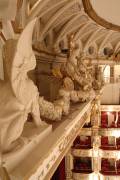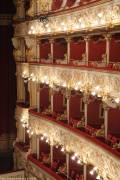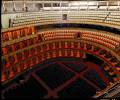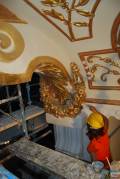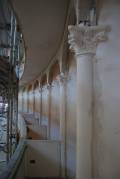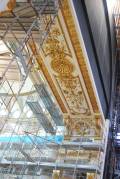Bari’s Petruzzelli theatre is the fourth largest theatre in Italy, a beacon of elegance in its architectural lines and interiors, inspired by early 20th century trends.
Nearly destroyed by arson in 1991, its reconstruction took on a value that vastly exceeded the mere restoration of a building.
In 2009, after 17 years, works were finally completed and the Petruzzelli theatre was returned to the city of Bari and its citizens. Three different tender offers needed to be awarded to proceed with the restoration: in 2007, the last contract was awarded to Cobar for the reconstruction work on the main body of the theatre.
[...]Read MoreBari’s Petruzzelli theatre is the fourth largest theatre in Italy, a beacon of elegance in its architectural lines and interiors, inspired by early 20th century trends.
Nearly destroyed by arson in 1991, its reconstruction took on a value that vastly exceeded the mere restoration of a building.
In 2009, after 17 years, works were finally completed and the Petruzzelli theatre was returned to the city of Bari and its citizens. Three different tender offers needed to be awarded to proceed with the restoration: in 2007, the last contract was awarded to Cobar for the reconstruction work on the main body of the theatre.
From the very beginning, reconstruction appeared to be quite complex, both for the absence of adequate insurance coverage, and for the private ownership of the theatre. In 1994, the National Treasury awarded around €2 million directly to the owners of the theatre, for the removal of rubble, safety compliance and for reconstruction of the roofs.
These works were completed in 1998. In 2003, the National Treasury allocated an additional €10 million, entrusting their management to the Regional Superintendence and, following a tender offer, the undertaking completed the first section of the works on behalf of the property, and proceeded with the recovery of the foyer: this area was only marginally damaged by the fire, but heavily deteriorated by the extreme heat and fumes generated by the flames.
In 2007, following a tender offer, the completion works for the reconstruction of the Petruzzelli theatre were awarded.
The site generated particular interest because of the coexistence of two problems: the often peculiar issues related to restoration sites, and the higher technological needs of a modern large theatre. These complex issues have been magnified by the tight schedule for the execution of the works, carried out over a period of 18 months. During the execution of the work, a laboratory of about 2000 sqm was set up, in which around thirty restorers, sculptors and decorators reconstructed all the decorative apparatus, that was partly removed during previous restorations and partly destroyed by fire.
The decorative apparatus that adorned the interior of the Petruzzelli theatre features a series of sculptures, bas-reliefs and high-reliefs made with different techniques and material, namely stucco decorations, papier-mâché, paintings on plaster, oil paintings on canvas and wooden decorations. This legacy had already been modified, and partly lost, during the restoration works that preceded the fire. During the latest theatre restoration, a careful reconstruction of the interior decorations was carried out.
The stucco decoration findings constituted a precious source of information on the features of the lost decorations: firstly, Cobar proceeded with a thorough analyses of the historical photographic documentation; then, using photogrammetry and calibration programs, it was possible to obtain a very accurate scale reproduction of the existing decoration. Since the reconstruction and restoration of the decorative apparatus would have had to go hand in hand with the general progress of the works, it was necessary to proceed with innovative techniques that would ensure a speedy execution.
This reconstruction process includes about one hundred and fifty very complex and rich elements, such as the proscenium beam, the sculpture section of the same beam, the vomitorium and the dome with its modillions and bulls with foliage. The vast majority of the elements are distributed in all areas of the theatre, therefore several thousand elements needed to be modelled: a complex work that aims at harmonising and harmoniously combining a vast array of components.
Meticulous work has been carried out for the fastigium on the proscenium arch, created at the time by sculptor Pasquale Duretti: its reproduction has been faithfully recreated, maintaining the original proportions.
The dome was originally painted by Armenise: given the impossibility to recover the fresco, it was reconstructed and painted in a soft ochre colour, in line with the remaining parts of the room, so that the original painting divided into four lunettes could be projected onto it, exactly as it once was.
The careful reconstruction of the interior models, restored to their original form, has thus allowed the return of the unmistakable atmosphere and feel of the Petruzzelli theatre.
In this spirit, and in particular relation to the symbolic function of the Petruzzelli theatre for the city of Bari, the main objective of the project was the preservation of the architectural identity of the building: it was therefore vital that the core elements that make the theatre immediately recognisable, like cavea’s spacing, the foyer and its decorative apparatus needed to be carefully preserved.
Both in the recovery and in the indispensable transformations of functional adaptation to the needs of a modern and productive theatrical structure, the architectural project was articulated around two fundamental themes: the preservation of the monument and its spatial and material qualities; the integration of the parts that were incomplete or destined to new functions, while respecting the original layout and the compliance to modern safety standards.
The interventions focused on consolidating the load-bearing structures, replacing and restoring damaged or destroyed structural elements. In particular, the following operations were carried out: the reconstruction of the completely destroyed stalls and stage covers, the consolidations, the replacements and the restoration of the intermediate and covering horizons, the consolidation, the detachment and the cataloguing of the findings from the decorative apparatus in the hall, the demolition and the following reconstruction of the structural parts that can no longer be recovered, the consolidation of the vertical bearing elements, as well as the restoration of the masonry and of part of the cornices on the external perimeter broken up by the collapses. Additionally, renovation works have also focused on the external façades where careful operations were carried out on the micro-scales and the stains caused by rising damp from the stone basement, on the overhanging cornices damaged by oxidation of the metal structure and on the plasters.
In the areas that needed restructuring, the project included new architectural insertions, both area-specific (coatroom, ticket office, bar, employee entrance) and extensive (scenic apparatus). As they were immediately recognizable in their contemporary function, they have been approached with care by following the criteria of non-intrusiveness, reversibility, and technological innovation, with their careful addition to the inside of the building that was being brought back to its ancient splendour.
The compliance to safety regulations has also represented an important side of the intervention of restructuring of the theatre: plans were necessarily made to include new safety stairs to ensure a safe exit for the spectators from the hall (appropriately placed in full respect of the architectural and symmetrical distribution pattern that characterizes the structure) and the refurbishing of pre-existing staircases in the area of the dressing rooms, and also between the hall and the scenic area.
Through filtered service passages, this distribution strategy connects all the safety staircases, ensuring that spectators have a full system of completely safe escape routes at their disposal, a system that is easy to identify and follow.
Particular attention has also been paid to the elimination of architectural barriers: the mechanization of vertical connections in the focal points of the pathway allows complete and comfortable access for the disabled to all areas of the theatre building, including control rooms and areas intended for employee use, such as the stage and the dressing rooms. These operations were carried out by employing innovative restoration techniques and using materials that mirrored the original ones as closely as possible.
Cobar has returned the theatre to the public “where it was, the way it was”, which is the core purpose of such a necessary conservative and restoration operation.
Read Less
























































































